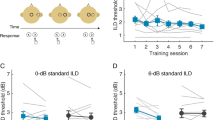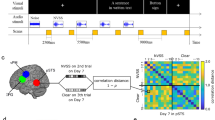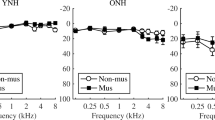Abstract
Young adults with normal hearing (YNH) can improve their sensitivity to basic acoustic features with practice. However, it is not known to what extent the influence of the same training regimen differs between YNH listeners and older listeners with hearing impairment (OHI)—the largest population seeking treatment in audiology clinics. To examine this issue, we trained OHI listeners on a basic auditory task (spectral modulation detection) using a training regimen previously administered to YNH listeners (∼1 h/session for seven sessions on a single condition). For the trained conditions on which pretraining performance was not already at asymptote, the YNH listeners who received training learned more than matched controls who received none, but that learning did not generalize to any untrained spectral modulation frequency. In contrast, the OHI-trained listeners and controls learned similar amounts on the trained condition, implying no effect of the training itself. However, surprisingly the OHI-trained listeners improved over the training phase and on an untrained spectral modulation frequency. These population differences suggest that learning consolidated more slowly, and that training modified an aspect of processing that had broader tuning to spectral modulation frequency, in OHI than YNH listeners. More generally, these results demonstrate that conclusions about perceptual learning that come from examination of one population do not necessarily apply to another.





Similar content being viewed by others
References
Ahissar M, Hochstein S (2004) The reverse hierarchy theory of visual perceptual learning. Trends Cogn Sci 8:457–464
Andersen GJ, Ni R, Bower JD, Watanabe T (2010) Perceptual learning, aging, and improved visual performance in early stages of visual processing. J Vis 10:4
Astle AT, Webb BS, McGraw PV (2010) Spatial frequency discrimination learning in normal and developmentally impaired human vision. Vision Res 50:2445–2454
Attebo K, Mitchell P, Cumming R, Smith W, Jolly N, Sparkes R (1998) Prevalence and causes of amblyopia in an adult population. Ophthalmology 105:154–159
Ball K, Sekuler R (1986) Improving visual perception in older observers. J Gerontol 41:176–182
Burk MH, Humes LE (2007) Effects of training on speech recognition performance in noise using lexically hard words. J Speech Lang Hear Res 50:25–40
Burk MH, Humes LE (2008) Effects of long-term training on aided speech-recognition performance in noise in older adults. J Speech Lang Hear Res 51:759–771
Chen PL, Chen JT, Fu JJ, Chien KH, Lu DW (2008) A pilot study of anisometropic amblyopia improved in adults and children by perceptual learning: an alternative treatment to patching. Ophthalmic Physiol Opt 28:422–428
Chi T, Ru P, Shamma SA (2005) Multiresolution spectrotemporal analysis of complex sounds. J Acoust Soc Am 118:887–906
Cox RM, Alexander GC, Taylor IM, Gray GA (1997) The contour test of loudness perception. Ear Hear 18:388–400
Dosher BA, Lu ZL (1998) Perceptual learning reflects external noise filtering and internal noise reduction through channel reweighting. Proc Natl Acad Sci U S A 95:13988–13993
Eddins D, Harwell R (2002) Spatial Frequency Channels in Audition? In: Midwinter Meeting of the Association for Research in Otolaryngology
Eddins DA, Bero EM (2007) Spectral modulation detection as a function of modulation frequency, carrier bandwidth, and carrier frequency region. J Acoust Soc Am 121:363–372
Henry BA, Turner CW, Behrens A (2005) Spectral peak resolution and speech recognition in quiet: normal hearing, hearing impaired, and cochlear implant listeners. J Acoust Soc Am 118:1111–1121
Huang CB, Lu ZL, Zhou Y (2009) Mechanisms underlying perceptual learning of contrast detection in adults with anisometropic amblyopia. J Vis 9(24):21–14
Huang CB, Zhou Y, Lu ZL (2008) Broad bandwidth of perceptual learning in the visual system of adults with anisometropic amblyopia. Proc Natl Acad Sci U S A 105:4068–4073
Huyck JJ, Wright BA (2011) Late maturation of auditory perceptual learning. Dev Sci 14:614–621
Karni A, Sagi D (1993) The time course of learning a visual skill. Nature 365:250–252
Korman M, Raz N, Flash T, Karni A (2003) Multiple shifts in the representation of a motor sequence during the acquisition of skilled performance. Proc Natl Acad Sci U S A 100:12492–12497
Kowalski N, Depireux DA, Shamma SA (1996) Analysis of dynamic spectra in ferret primary auditory cortex. I Characteristics of single-unit responses to moving ripple spectra Journal of neurophysiology 76:3503–3523
Levitt H (1971) Transformed up-down methods in psychoacoustics. The Journal of the Acoustical Society of America 49: Suppl 2:467 +
Li RW, Klein SA, Levi DM (2008) Prolonged perceptual learning of positional acuity in adult amblyopia: perceptual template retuning dynamics. J Neurosci 28:14223–14229
Litvak LM, Spahr AJ, Saoji AA, Fridman GY (2007) Relationship between perception of spectral ripple and speech recognition in cochlear implant and vocoder listeners. J Acoust Soc Am 122:982–991
Macpherson EA, Middlebrooks JC (2003) Vertical-plane sound localization probed with ripple-spectrum noise. J Acoust Soc Am 114:430–445
Marrone N, Hu R, Wright BA (2010) Age-related changes in auditory perceptual learning. Association for Research in Otolaryngology Abstracts 33
McGaugh JL (2000) Memory–a century of consolidation. Science 287:248–251
Ortiz JA, Wright BA (2010) Differential rates of consolidation of conceptual and stimulus learning following training on an auditory skill. Exp Brain Res 201:441–451
Peelle JE, Wingfield A (2005) Dissociations in perceptual learning revealed by adult age differences in adaptation to time-compressed speech. J Exp Psychol Hum Percept Perform 31:1315–1330
Polat U, Ma-Naim T, Belkin M, Sagi D (2004) Improving vision in adult amblyopia by perceptual learning. Proc Natl Acad Sci U S A 101:6692–6697
Qian J, Eddins DA (2008) The role of spectral modulation cues in virtual sound localization. J Acoust Soc Am 123:302–314
Sabin AT, Eddins DA, Wright BA (2012a) Perceptual learning evidence for tuning to spectrotemporal modulation in the human auditory system. J Neurosci 32:6542–6549
Sabin AT, Eddins DA, Wright BA (2012b) Perceptual learning of auditory spectral modulation detection. Exp Brain Res 218:567–577
Saoji AA, Eddins DA (2007) Spectral modulation masking patterns reveal tuning to spectral envelope frequency. J Acoust Soc Am 122:1004–1013
Schreiner C, Calhoun B (1994) Spectral envelope coding in cat primary auditory cortex: properties of ripple transfer functions. Audit Neurosci 1:39–61
Shamma S, Versnel H, Kowalski N (1995) Ripple analysis in ferret primary auditory cortex. I. Response characteristics of single units to sinusoidal rippled spectra. Audit Neurosci 1:233–254
Sowden PT, Rose D, Davies IR (2002) Perceptual learning of luminance contrast detection: specific for spatial frequency and retinal location but not orientation. Vision Res 42:1249–1258
Supin A, Popov VV, Milekhina ON, Tarakanov MB (1999) Ripple depth and density resolution of rippled noise. J Acoust Soc Am 106:2800–2804
Sweetow RW, Sabes JH (2006) The need for and development of an adaptive Listening and Communication Enhancement (LACE) Program. J Am Acad Audiol 17:538–558
Versnel H, Kowalski N, Shamma SA (1995) Ripple analysis in ferret primary auditory cortex. III Topographic distribution of ripple response parameters Audit Neurosci 1:271–285
Walden BE, Erdman SA, Montgomery AA, Schwartz DM, Prosek RA (1981) Some effects of training on speech recognition by hearing-impaired adults. Journal of speech and hearing research 24:207–216
Walker MP, Stickgold R (2004) Sleep-dependent learning and memory consolidation. Neuron 44:121–133
Wright BA, Wilson RM, Sabin AT (2010) Generalization lags behind learning on an auditory perceptual task. J Neurosci 30:11635–11639
Wright BA, Zhang Y (2009a) Insights into human auditory processing gained from perceptual learning. In: The cognitive neurosciences vol. IV (Gazzaniga, M. S., ed), pp 353–366 Cambridge, MA: MIT
Wright BA, Zhang Y (2009b) A review of the generalization of auditory learning. Philos Trans R Soc Lond B Biol Sci 364:301–311
Acknowledgments
This work was supported by grants F31DC009549 (ATS), R01DC004453 (BAW), and a capstone grant from the Northwestern Doctor of Audiology Program (CAC). Nikki Taft helped with data collection. Sumitrajit Dhar helped with experiment design. Christopher Turner provided code for stimulus generation in the ripple reversal task. Nicole Marrone, Yuxuan Zhang, and Julia Huyck provided helpful discussions on this work.
Author information
Authors and Affiliations
Corresponding author
Rights and permissions
About this article
Cite this article
Sabin, A.T., Clark, C.A., Eddins, D.A. et al. Different Patterns of Perceptual Learning on Spectral Modulation Detection Between Older Hearing-Impaired and Younger Normal-Hearing Adults. JARO 14, 283–294 (2013). https://doi.org/10.1007/s10162-012-0363-y
Received:
Accepted:
Published:
Issue Date:
DOI: https://doi.org/10.1007/s10162-012-0363-y




